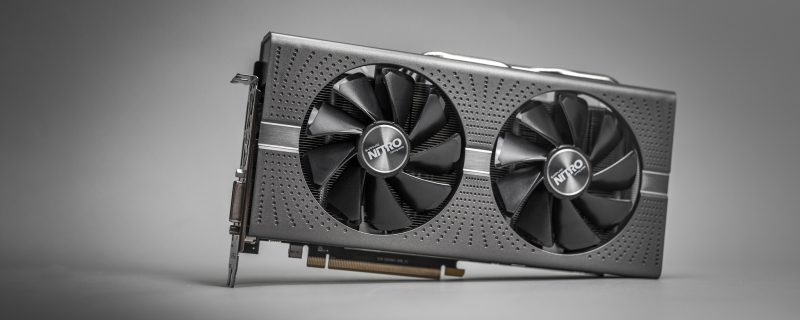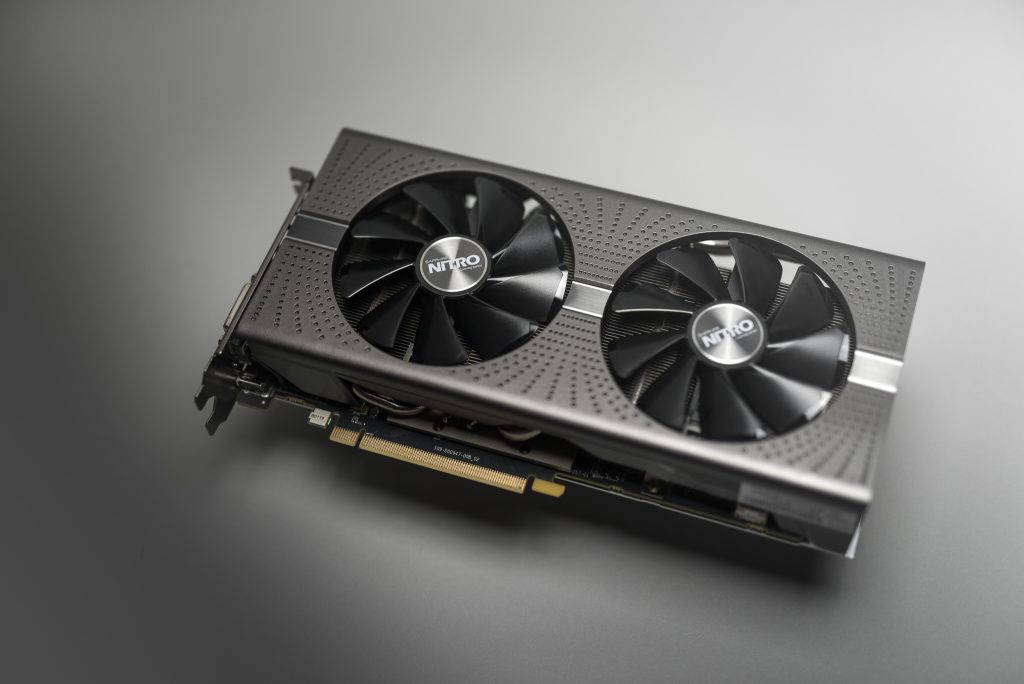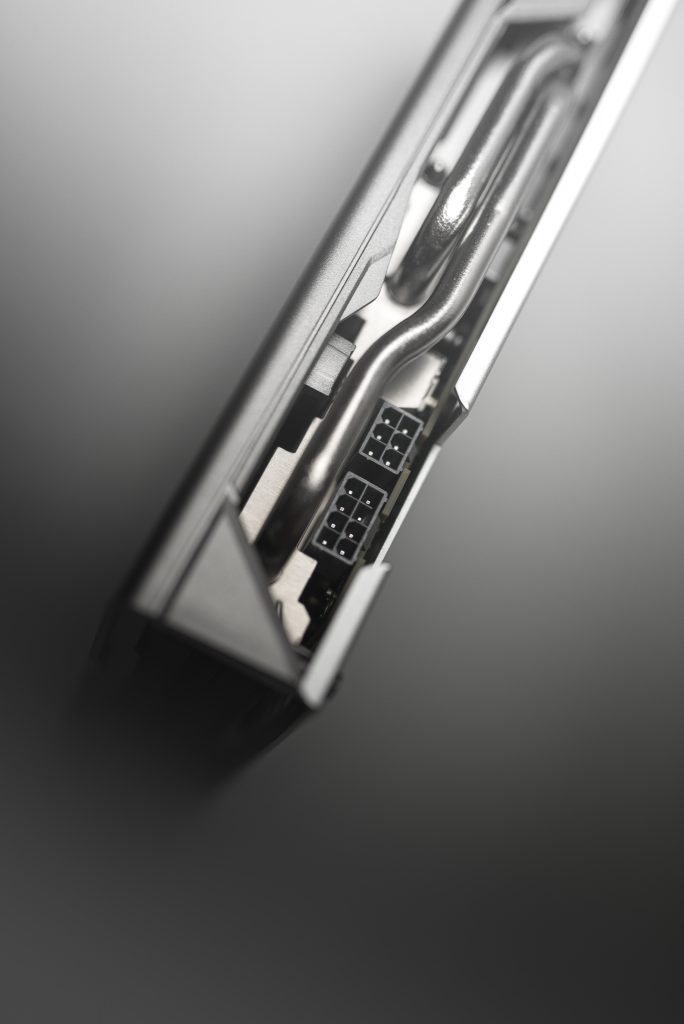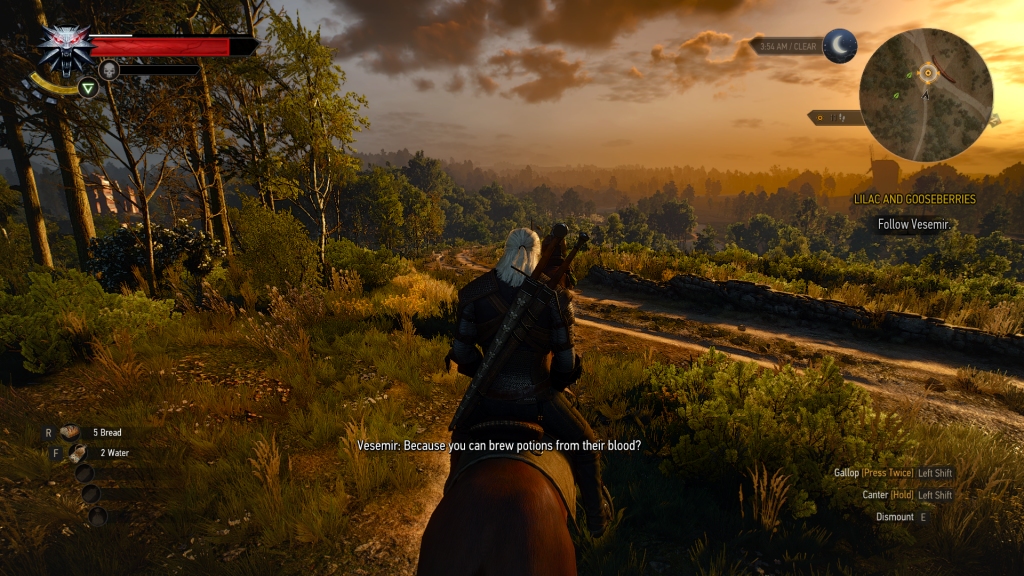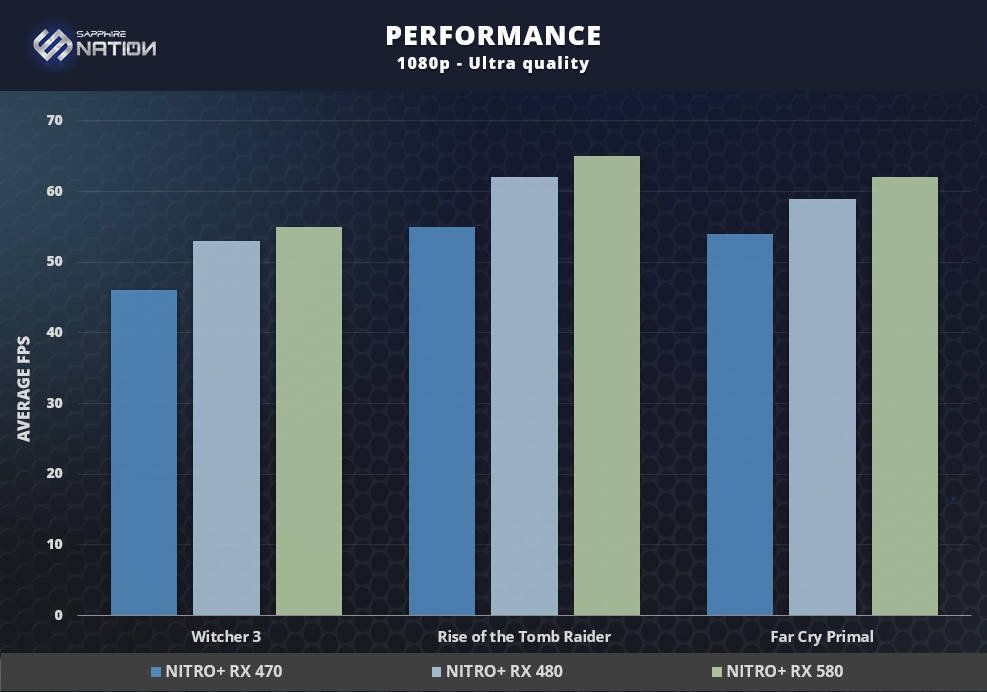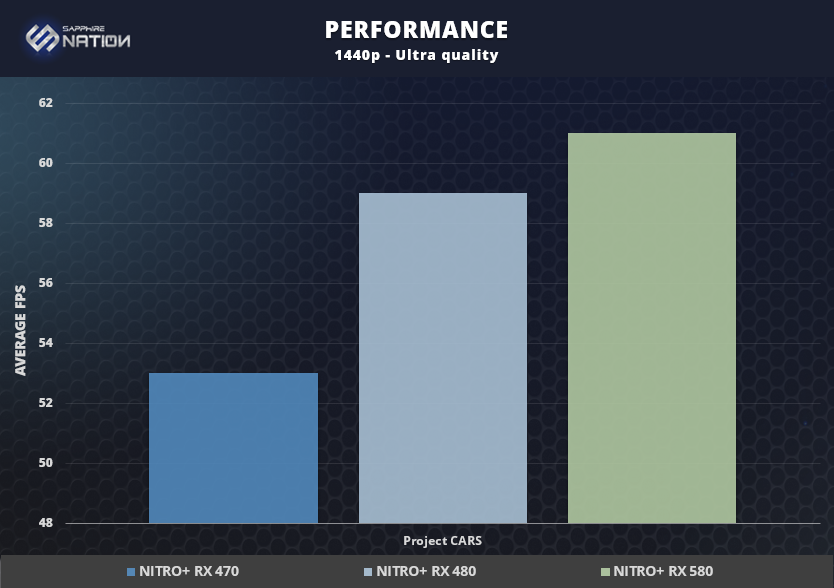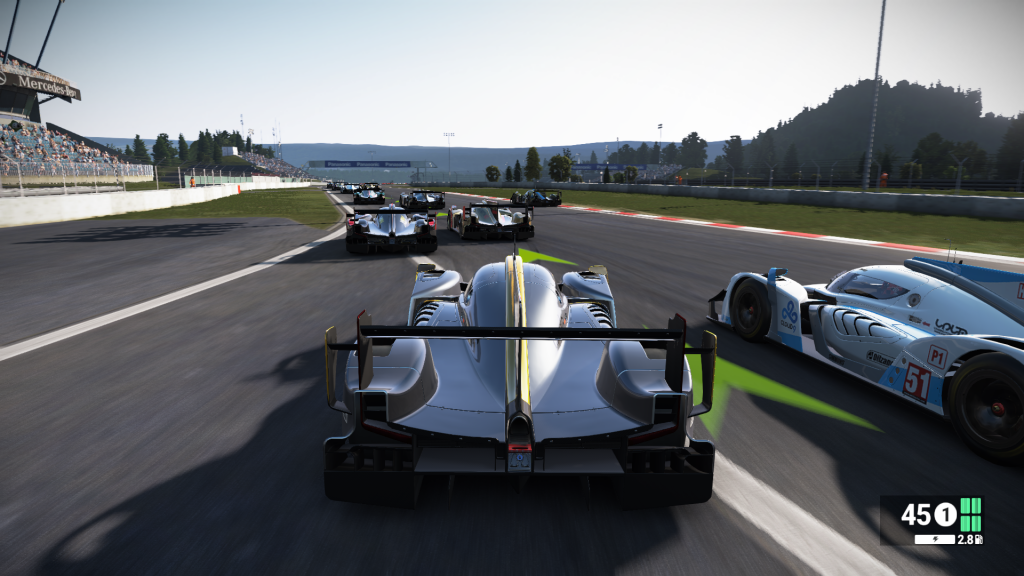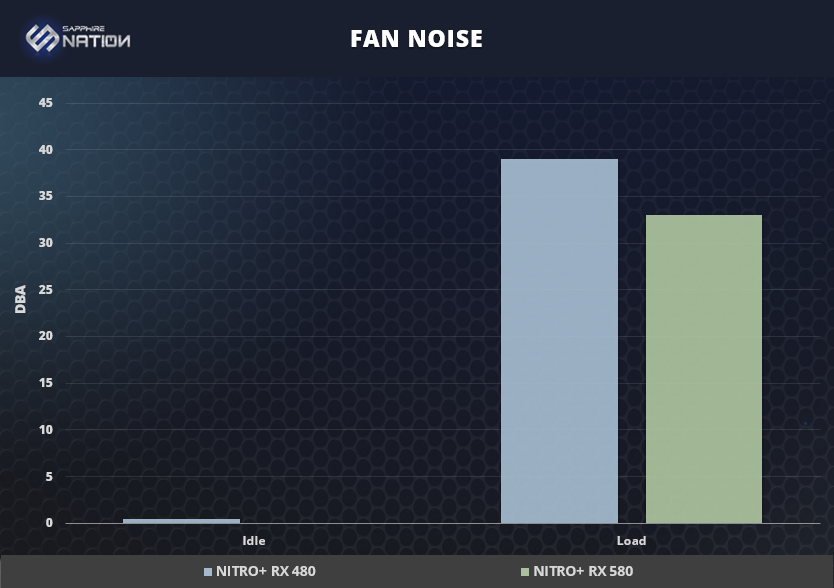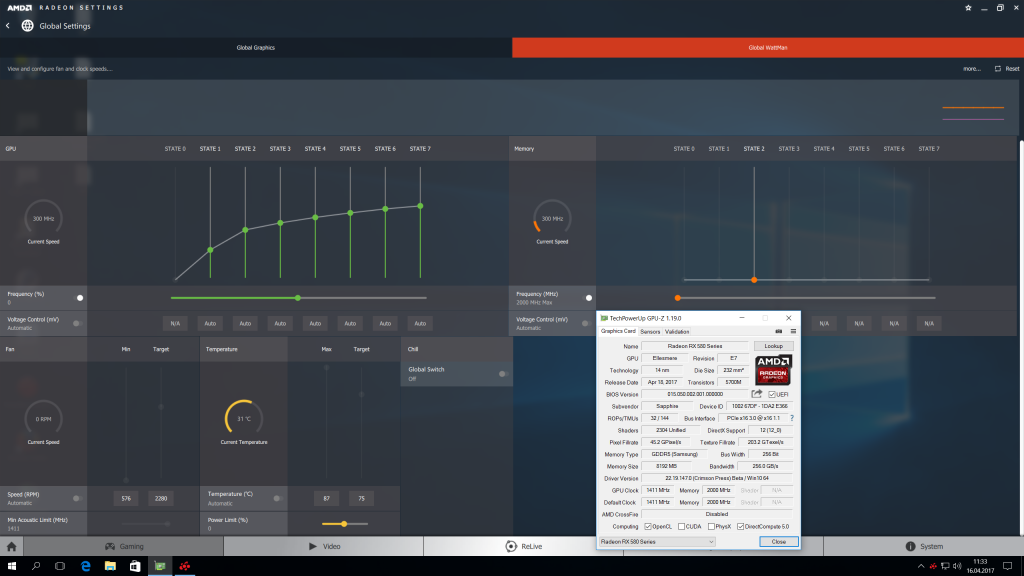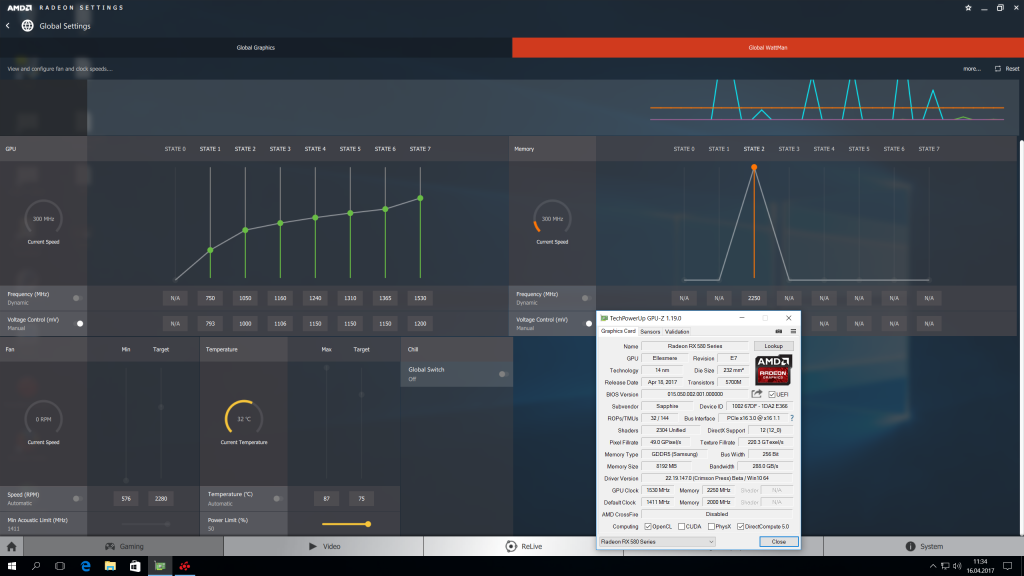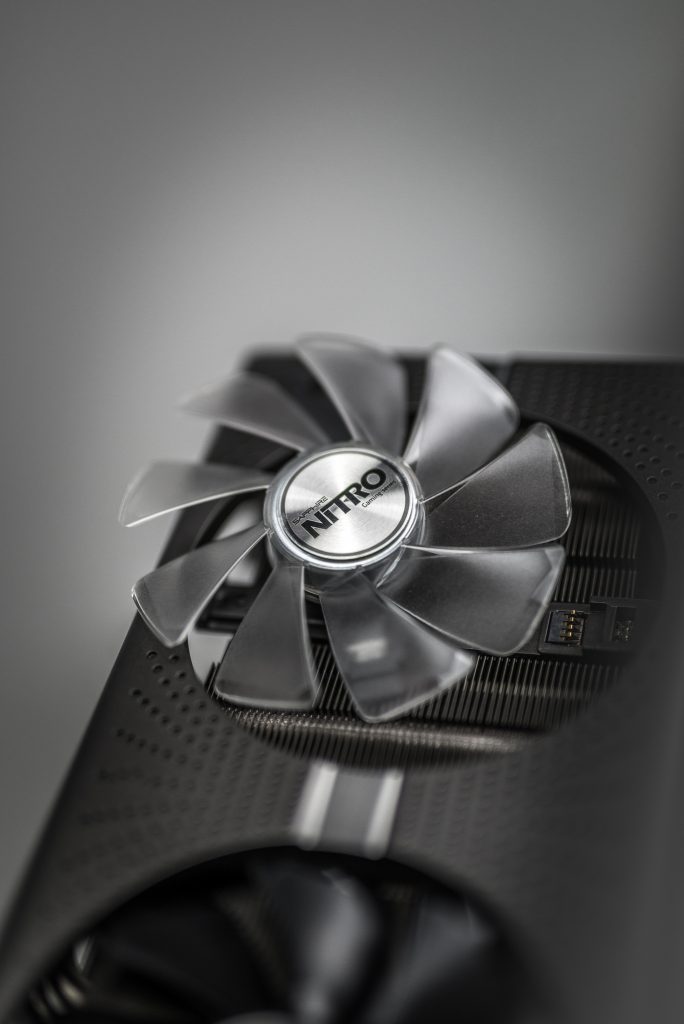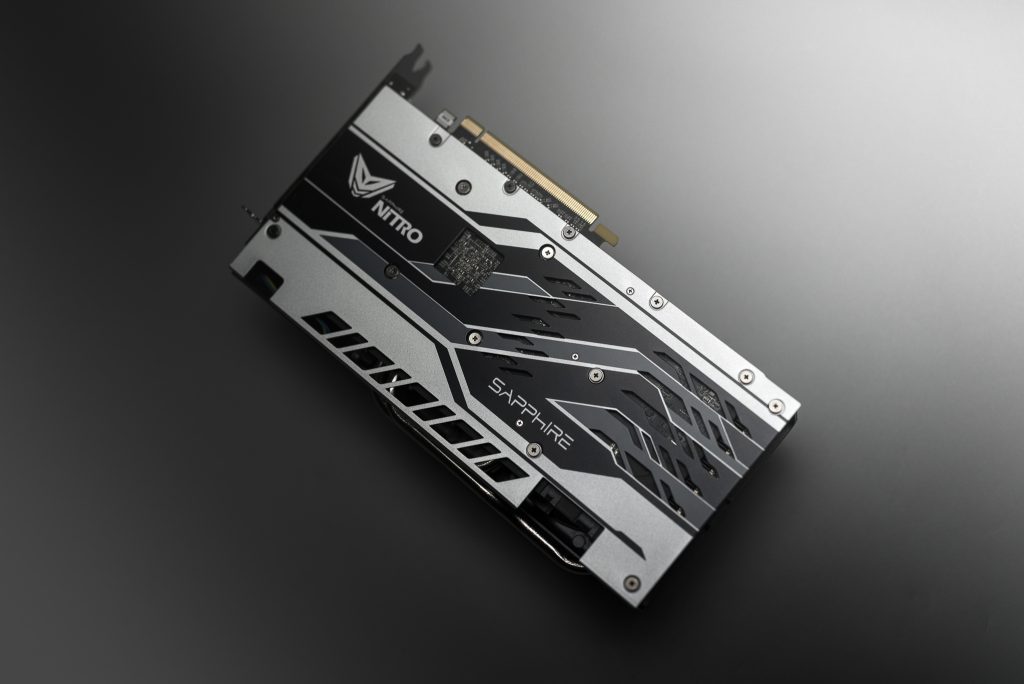
Last year’s release of the Radeon RX 480 was a very successful one. AMD managed to deliver a highly competitive product that quickly became one of the best selling GPUs on the market. However, the RX 480 is no longer the fastest Polaris-based GPU available. That’s right, AMD’s got a new player ready to join the game and dominate the competition – the Radeon RX 580. And today we will talk about the best card it’s featured in – the new SAPPHIRE NITRO+ Radeon RX 580 Limited Edition.
Just as usual, SAPPHIRE’s prepared its own non-reference design at the launch of the new series in order to deliver more power and satisfy the needs of all enthusiasts who believe that style matters. The main goal of the company has been to create a very efficient and exceptionally quiet cooler that’s going to keep the GPU cool enough to enable a factory overclock and bump the performance even further. Of course, the award winning SAPPHIRE NITRO series of graphics cards isn’t just about performance. There are many exciting and highly innovative features on board that make the card stand out from the crowd. But before we get to them, let’s take a look at AMD’s newest GPU.

Like the RX 480, the RX 580 is based on AMD’s newest silicon, code-named “Ellesmere”. This GPU is in essence just another implementation of Polaris 10, GCN’s 4th generation architecture. It offers big-time improvements to memory bandwidth saving and asynchronous compute. All 36 of the chip’s CU’s are enabled in RX 580, giving it 2304 stream processors and 144 texture mapping units, a 12,5% increase over pre-Polaris R9 380X. Like its predecessor, the chip features 32 ROPs. GDDR5 8 Gb/s memory, combined with a 256-bit memory bus, provides 256 GB/s of bandwidth – a respectable value, especially given the updated delta color compression algorithm it uses.

The SAPPHIRE NITRO+ RX 580 features SAPPHIRE’s next generation custom cooling solution, a major upgrade over the previous members of the NITRO+ family. Our sample, being the Limited Edition version, also features the highest binned GPU and therefore guarantees exceptional overclocking capabilities. Intelligent Fan Control III with NITRO CoolTech ensures that the fans don’t rotate as long as GPU temperature remains under 52 °C (126 °F). Dual-X incorporates two ball bearing (85% longer lifespan) fans with transparent blades and LED illumination and is completely noiseless under low-load operation thanks to its semi-passive nature. The card comes overclocked out of the box to a GPU clock of 1450 MHz – that’s about 8% higher than the reference clocks, and it makes the NITRO+ Limited Edition one of the highest clocked RX 580 cards on the market. Needless to say, 1450 MHz is also much more than most RX 480s could do on air. Memory frequency has remained at 2000 MHz, which should come as no surprise—there is no faster GDDR5 chip available.
| SAPPHIRE NITRO+ Radeon RX 480 | SAPPHIRE NITRO+ Radeon RX 580 Limited Edition | |
| Graphics Processor | Ellesmere | Ellesmere |
| Transistors | 5700M | 5700M |
| Shader Units | 2304 | 2304 |
| ROPs | 32 | 32 |
| TMUs | 144 | 144 |
| Core Clock | 1342 MHz | 1450 MHz |
| Memory Clock | 2000 MHz | 2000 MHz |
| Memory Size | 8192 MB | 8192 MB |
| Memory Bus | 256 bit | 256 bit |
| Memory Bandwidth | 256 GB/s | 256 GB/s |
The card
The SAPPHIRE NITRO+ RX 580 Limited Edition is based on the company’s custom PCB, designed specifically for this card. Speaking of visual aspects, the most obvious difference in comparison with the NITRO+ RX 480 is the RX 580’s unique design with a gunmetal gray shroud that looks incredibly good. The card itself is not very long and measures only 265 mm. Because of that, it shouldn’t cause any problems during installation, even in smaller cases.
There is a stylish all-aluminum backplate on the back of the card. It helps cool sensitive components, provides extra protection and also reinforces the cooler mounting. The backplate is simply gorgeous, it is undoubtedly one of the best-looking designs on the market.
Power delivery requires two (8-pin and 6-pin) PCIe power connectors. This is an obvious upgrade over the NITRO+ Radeon RX 480, which had a single 8-pin connector. More power means higher clocks and unconstrained overclocking potential. Because of the modest size of the Dual-X cooling system, installation requires only two slots.
Display connectivity options include a single DVI-D port (no analog output), two full-size DisplayPort 1.4 HDR ports and two HDMI 2.0b ports. There is another thermal optimization measure here, as SAPPHIRE’s engineers also put air vents in the I/O section to enable more efficient heat dissipation.
Each fan’s diameter is exactly 95 mm. Both feature translucent blades that make the LED illumination even more spectacular. Although they aren’t the largest ones out there, they are still capable of delivering decent airflow with moderate noise levels. Thanks to their innovative design, they are also 10% quieter than the previous generation in SAPPHIRE’s offer.
The Fan Check feature allows you to monitor the fans’ health (available in the TriXX utility). Yet another important feature is Quick Connect. Both fans are attached with just a single screw so you can quickly remove them to clean or replace them without the need to disassemble the cooler’s shroud or any other parts of the card. What is more, there are also two spare fans included for your convenience. This makes RMA much easier and less inconvenient in case of fan failure. However, you should keep in mind that the spare fans incorporate regular black blades, not transparent ones.

The Dual BIOS switch allows you to choose between Quiet and Boost modes. The quiet mode runs at 1411 MHz, with the fan profile tuned to operate as quietly as possible at the cost of small performance drop. In default Boost mode, the card unleashes its full potential by increasing the frequency to 1450 MHz and switching to a more aggressive fan curve.
Last but not least, feast your imagination on SAPPHIRE’s NITRO Glow, a beautiful RGB LED illumination on the card’s top. It can work in various modes and is fully customizable through the TriXX utility. As the table below shows, there are six default modes, including color changes that indicate current fan speed or temperature.
| LED colour Modes | Function/State |
| SAPPHIRE Blue | Static blue |
| Rainbow | Phasing colours |
| PCB Temperature Indicator | < = 60 °C slow breathing blue (6 secs)
> 60 °C <70 °C mid-slow breathing light purple (3 secs) > 70 °C < 80 °C mid-slow breathing deep purple (3 secs) > 80 °C faster breathing red (2 secs) |
| Fan Speeds | 0 ~ 200 RPM slow breathing blue (6 secs)
> 201 < 1000 RPM mid-slow breathing light purple (3 secs) > 1001 < 1500 RPM mid-slow breathing deep purple (3 secs) > 1501 RPM faster breathing red (2 secs) |
| Customized LEDs | End user can customize the color. Static State. |
| LEDs off |
Test Setup
| Processor | AMD Ryzen 7 1800X @ 4,1 GHz |
| Motherboard | MSI X370 SLI Plus |
| Memory | Klevv Cras 16 GB DDR4 @ 2666 MHz CL 14-15-15-35-1T |
| Hard Disk | Seagate Barracuda 7200.12 1 TB |
| Power Supply | SilentiumPC Supremo M1 700 W |
| Case | Antec Twelve Hundred V3 |
| Display | AOC Q2770PQU |
| Operating System | Microsoft Windows 10 64-bit AU |
| Drivers | Radeon Software Crimson ReLive 17.10 |
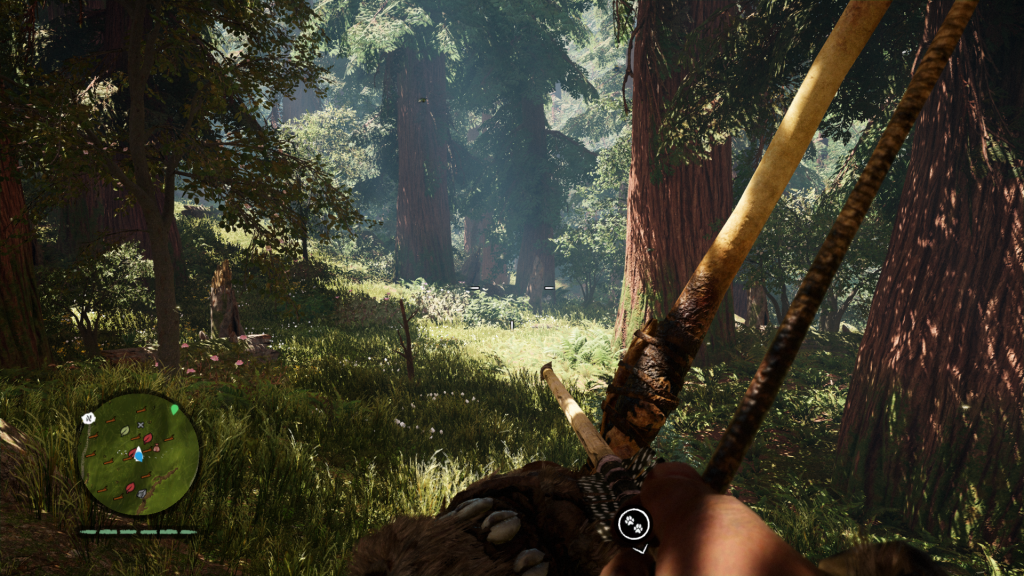


The card is about 5% faster than the NITRO+ RX 480 thanks to its higher GPU clocks. NITRO+ RX 580 is also over 15% faster than the NITRO RX 470. This enables smoother and more pleasant gameplay with less stuttering.
Temperatures and fan noise
The SilentiumPC Supremo M1 700 W is a semi-passive PSU—and the perfect choice for high-quality fan noise tests that shouldn’t be affected by any auxiliary fans. The ambient noise was exactly 32,5 dBA. Room temperature ranged from 21 to 22 °C. GPU-Z 1.9.0 was used to perform the temperature readings. Both graphics cards were tested with 15 minutes of The Witcher 3: Wild Hunt gameplay and left for 10 minutes to cool down.
The fan-noise tests were conducted with a Voltcraft SL-100 digital sound level meter placed 40 cm from the case, at the projected height of a user’s ears. All other fans were turned off for the duration of the tests.
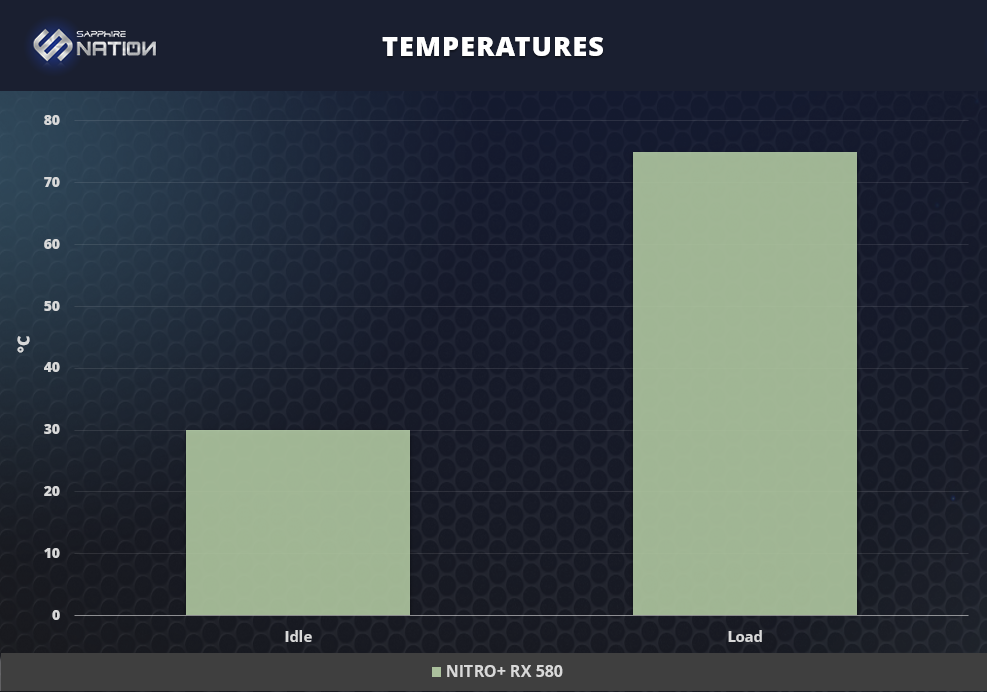
The Dual-X is undoubtedly a very efficient cooling solution. It had no problem keeping GPU temperatures at satisfactory levels, allowing the RX 580 to perform without any slowdowns due to thermal throttling. SAPPHIRE promised a 75 °C (167 °F) temperature target and this is exactly what the user gets. More importantly, the fan is nearly noiseless. SAPPHIRE NITRO+ RX 580’s fans run at about 1100 RPM under load, and barely exceed the ambient noise. What’s the secret behind this magic? Well, it’s very simple. Compared to NITRO+ RX 480, this card has an additional heat pipe and the heat dissipation area is larger too. As you can see, the results are spectacular.
Power Consumption
Power consumption readings were carried out with a Voltcraft Energy Logger 4000F. This device is in the ±1% accuracy class and operates in True RMS mode. The power socket delivered 230 V @ 50 Hz for us. All values on the charts refer to the entire test setup, not just the graphics cards.

As you can see, our test setup’s power draw was about 40 W higher with the NITRO+ RX 580 than with the NITRO RX 470. Considering the performance difference between these cards, it’s safe to conclude that power efficiency is unaffected by the RX 580’s very high stock clocks.
Overclocking
The overclocking results listed in this section were achieved with AMD’s WattMan utility combined with SAPPHIRE’s own tool – TriXX. Power limits and fan speed were maxed out to remove any potential bottlenecks during the overclocking. Then, to really put its stability to the test, we subjected the card to 15 minutes of intensive The Witcher 3: Wild Hunt gameplay.
The combination of WattMan and TriXX allowed us to increase the GPU voltage to around 1,25 V, allowing us to open up breakneck GPU speeds. The maximum overclock of our sample was 1530 MHz (1490 MHz without additional voltage adjustments) on the GPU – about 5,5% higher than the stock frequency. GDDR5 memory also showed very high OC potential. We managed to max out WattMan’s frequency limit of 2250 MHz without any stability issues. That is exactly 12,5% above the stock value, clearly a respectable score. Both GPU and memory clocks are way higher than any RX 480 could do on air or water-cooling. What else can we say here?
Overclocking provides a nice performance boost of 8,3%.
Conclusion
Why you’d choose the SAPPHIRE NITRO+ Radeon RX 580 Limited Edition:
- Faster than NITRO+ Radeon RX 480
- Cherry-picked GPU
- Highly overclocked out of the box
- Very good overall performance
- Crazy overclocking capabilities
- Noiseless in idle
- Nearly noiseless under load
- Low temperatures
- Good power efficiency
- Unique and stylish design
- Backplate included
- NITRO Glow illumination
- Fan features including Quick Connect, Fan Check and transparent blades
- Two spare fans included
- DisplayPort 1.4 HDR and HDMI 2.0b ports
- Dual BIOS
Without a doubt, SAPPHIRE NITRO+ RX 580 is a wonderful graphics card for all gamers looking for a fast mid-range GPU. Its performance is really good, being noticeably higher than previous NITRO cards available on the market. What is more, 8192 MB of VRAM is perfectly suitable for games that use more and more memory for textures – current and future ones alike. Remember, you need not be stuck with just 4096 MB or even less these days.
When it comes to gaming, it is important that you don’t let the others fool you. DirectX 12 and Vulkan ARE the future of gaming and it is only a matter of time until they become dominant APIs. Because of that, it is essential that you own a future-proof GPU like the RX 580. Its DirectX 12 features and performance may be real game changers in the nearest future. We can already see considerable gains in current DX 12 titles and there will be more and more of these games coming for sure. Vulkan API also offers chance for performance boosts, as evidenced by Doom tests. Modern display ports like DisplayPort 1.4 HDR and HDMI 2.0b are very important as well because they will provide full compliance with upcoming displays.
Another important advantage of the SAPPHIRE NITRO+ RX 580 is its Dual-X cooling system, which is a major improvement over AMD’s design and has been further revised in comparison with the NITRO+ RX 480. SAPPHIRE’s Dual-X does a magnificent job here at keeping the Ellesmere GPU at even lower temperatures and therefore preventing any thermal throttling. What is more, you won’t hear a thing in all low-load scenarios because of its semi-passive operating mode. Dual-X is also a very versatile cooler with nearly unlimited potential. All you have to do is to manually adjust the fan speed according to your needs. Quite obviously, this is especially desirable when overclocking. However, if you decide to stick to stock frequencies, we guarantee that you won’t hear a thing, even while gaming.
Speaking of overclocking, it would be a shame not to mention SAPPHIRE NITRO+ RX 580’s crazy capabilities. Our sample did not have any problems hitting over 1500 MHz GPU clocking, a feat that was just not possible with previous RX 480 cards. Of course, SAPPHIRE’s exclusive technologies are also very important and worth mentioning. Dual BIOS, Fan Check and Quick Connect are the most useful ones, because they simply make our lives easier in certain situations, like RMA. The gorgeous NITRO Glow illumination looks better than ever thank to fans’ transparent blades and is fully customizable and can provide certain information about the current state of the card. SAPPHIRE has also improved power delivery without affecting performance per watt.
This card is a great offer for all gamers looking for superior performance, astonishing overclocking capabilities, and an efficient and very quiet cooling solution, all combined with outstanding build quality. If you’re in the market for an RX 580-based card, check out the SAPPHIRE NITRO+ RX 580 Limited Edition. It has a perfect blend of strength, prestige and elegance. Highly recommended for all enthusiasts!





